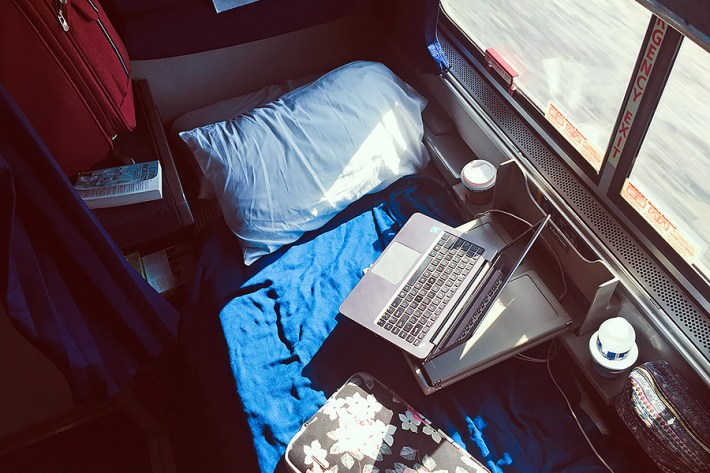During the COVID-19 pandemic I've tried to do my part to stop the spread by avoiding spending time indoors with non-household members. The main exception has been occasional use of public transportation, but studies indicate that transit isn't a major source of transmission, thanks to the fact that most people are masked and there's generally decent ventilation.
Along with commuting around the city by bus and 'L' for more-or-less essential purposes, I've taken a couple of Metra + bicycle road trips. For the Fourth of July, I rode Metra's Union Pacific West line to its western terminus in Elburn, and then biked to Oregon State Park, halfway across Illinois along the Rock River, after which I pedaled north to Rockford, where I caught the bike-friendly Van Galder bus line back to O'Hare and the Blue Line. And in September I took the Union Pacific Northwest line to Harvard and biked to Madison, Wisconsin, for an outdoor visit with a family member.

Last week was my first time riding Amtrak during COVID, joining some old friends who were taking a bike trip around eastern Iowa and western Illinois for spring break. Illinois case numbers were relatively low (although, in the wake of the easing of restrictions on restaurants and bars they're creeping up again), so it seemed like a reasonably safe thing to do.
Like Chicago's local transit agencies, Amtrak assures the public that it's going above and beyond to provide safe conditions on its vehicles. The railroad says it's been been focusing on making as many aspects of a trip as possible touch-free, including contactless boarding and scanning tickets directly from the Amtrak app, and it plans to install new ticket kiosks this year.

Amtrak adds that it's stepped up cleaning and disinfection of its facilities. "Customers can travel with extra confidence knowing all our trains are equipped with onboard filtration systems with a fresh air exchange rate every 4-5 minutes," the railroad states. And the agency is currently working on getting all of its employees vaccinated. Its pandemic safety strategies are partly informed by a partnership with George Washington University's Milken Institute School of Public Health.
While federal and Illinois rules mandate that passengers and workers wear masks on trains (and transit buses), CTA and Metra staff are instructed not to confront noncompliant riders. However, during my Amtrak trips, there were announcements that riders who refuse to cover their faces would be required to leave the train. Compliance was pretty good, although not perfect.

Starting on May 23, Amtrak will no longer be limiting capacity. When shopping for tickets on the railroad's website, the percentage of tickets sold so far on each run is displayed to help customers make an informed decision. And if the train on which you've bought a ticket gets too crowded for your comfort level, you can change the ticket at no cost.

If your budget allows, purchasing a private sleeper room on Amtrak is a somewhat safer option, since you'll be traveling in your own space, and it's also a relatively comfortable way to go. On our trip to Iowa, there were a full 90 passengers in these rooms, so the staff had their hands full accommodating them.
For our journey, we took the California Zephyr, which runs from Chicago's Union Station to San Francisco, to Mt. Pleasant Iowa. While we were expecting to box our bikes at the station, which adds extra hassles on both ends of the trip, ultimately we were instead allowed to load our unboxed bikes into the baggage car. (You need to purchase a space for your cycle in advance for an extra fee.)

We spent the first night in Iowa camping at Geode State Park, then rode east again to the Mississippi River city of Burlington and crossed back into Illinois. Heading south along the river (the most scenic part of the trip), we visited one of the most interesting small towns in our state, Nauvoo.

This was where the Church of Jesus Christ of Latter-day Saints established an early capital that rivaled Chicago in population by the early 1840s. However, in 1844 Mormon leader Joseph Smith and his brother Hiram were arrested and shot to death by a mob at the jail in nearby Carthage.

The community soon relocated to Utah under the leadership of Brigham Young. In recent years the LDS Church has rebuilt the temple and other historic buildings and turned the town into a tourist destination.
After camping in lovely Nauvoo State Park, we headed east to Macomb, Illinois, the home of Western Illinois University, where we stayed in simple cabins at Spring Lake Park, another attractive spot on a lovely body of water. The park is managed by cycling enthusiast and former Macomb alderman Ryan Hansen, who gave us a warm welcome.
On our last day we headed north to Galesburg, birthplace of Illinois poet laureate Carl Sandburg, who first called Chicago the "City of the Big Shoulders," and home to Knox College. In addition to the California Zephyr, the local station also serves the Southwest Chief route to Los Angeles, plus the Illinois Zephyr run between Chicago and Quincy, which we caught the next morning. Like all local routes in our state, it offers roll on service (again, you have to purchase a spot in advance.)
All in all, I was fairly comfortable using Amtrak for this journey, so as long as we don't see another major spike in cases, I'll probably make more such trips this year as a safer alternative to flying for a vacation. But hopefully a critical mass of Americans will soon be vaccinated, so that concern will pretty much be a moot point.







